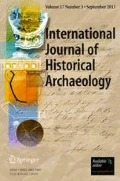Abstract
Consumer behavior and choice models have assumed a major role in historical archaeology. Recent interest in consumption is an honest attempt to move beyond an emphasis on production. Consumer models have clear material referents, making them useful in historical archaeology. These models, however, separate production from consumption, and privilege the autonomous individual as the preferred unit of analysis. They also reinforce and validate ideologies that obscure inequalities and power relations in modern society. For us the important issue is how people reproduce themselves as social beings. Focusing on social reproduction integrates both production and consumption.
Similar content being viewed by others
REFERENCES CITED
Appadurai, A. (ed.) (1986). The Social Life of Things: Commodities in Cultural Perspective, Cambridge University Press, Cambridge.
Cohen, L. (1982). Embellishing a life of labor: An interpretation of the material culture of working-class homes, 1885–1915. In Schlereth, T. J. (ed.), Material Culture Studies in America, The American Association for State and Local History, Nashville, pp. 289–305.
Cook, L. J., Yamin, R., and McCarthy, J. P. (1996). Shopping as meaningful action: Toward a redefinition of consumption in historical archaeology. Historical Archaeology 30(4): 50–65.
Dawley, A. (1976). Class and Community: The Industrial Revolution in Lynn, Harvard University Press, Cambridge.
Eagleton, T. (1996). The Illusion of Postmodernism. Blackwell Publishers, Oxford.
Ebert, T. L. (1995). (Untimely) critiques for a red feminism. In Zavarzadeh, M., Ebert, T., and Morton, D. (eds.), Post-Ality: Marxism and Postmodernism, Transformations. vol. 1. Maisonneuve Press, Washington, DC., pp. 113–149.
Ewen, S. (1976). Captains of Consciousness: Advertising and the Social Roots of Consumer Culture, McGraw-Hill, New York.
Ewen, S. (1988). All Consuming Images, Basic Books, New York.
Ewen, S. and Ewen, E. (1992). Channels of Desire: Mass Images and the Shaping of American Consciousness, University of Minnesota Press, Minneapolis.
Gibb, James A. (1996). The Archaeology of Wealth: Consumer Behavior in English America, Plenum Press, New York.
Godelier, M. (1986). The Mental and the Material: Thought, Economy and Society, Verso, London.
Jay, N. (1981). Gender and dichotomy. Feminist Studies 7(1): 38–56.
Klein, T. H., and LeeDecker, C. H. (1991). Models for the study of consumer behavior. Historical Archaeology 25(2).
Kristoff, N. D. (1998). Asia feels strain most at society's margins. New York Times 147(51, 182): A1, A8.
Larrain, J. (1995). Identity, the other, and postmodernism. In Zavarzadeh, M. U., Ebert, T. L., and Morton, D. (eds.), Post-Ality: Marxism and Postmodernism, Transformations. vol. 1. Maisonneuve Press, Washington, D.C., pp. 271–289.
McCracken, G. (1988). Culture and Consumption, Indiana University Press, Bloomington.
McGuire, R. H. (1991). Building power in the cultural landscape of Broome County, New York 1880–1940. In McGuire, R. H., and Paynter, R. (eds.), The Archaeology of Inequality, Blackwell, Oxford, pp. 102–124.
McKendrick, N. (1982). Josiah Wedgewood and the commercialization of potteries. In McKendrick, N., Brewer, J., and Plumb, J. H. (eds.), The Birth of a Consumer Society: The Commercialization of the Eighteenth Century, Indiana University Press, Bloomington, pp. 100–145.
Miller, D. (1987). Material Culture and Mass Consumption, Blackwell, Oxford.
Miller, D. (1995). Consumption and commodities. Annual Review of Anthropology 24: 141–161.
Miller, D. (ed.) (1996). Acknowledging Consumption: A Review of New Studies, Routledge, New York.
Mukerji, C. (1983). From Graven Images: Patterns of Modern Materialism, Columbia University Press, New York.
Spencer-Wood, S. M. (ed.) (1987). Consumer Choice in Historical Archaeology, Plenum Press, New York.
Veblen, T. (1899). The Theory of the Leisure Class, George Allen and Unwin, London.
Zavarzadeh, M. U. (1995). Post-ality: The (dis)simulations of cybercapitalism. In Zavarzadeh, M. U., Ebert, T. L., and Morton, D. (eds.), Post-Ality: Marxism and Postmodernism, Transformations. vol. 1. Maisonneuve Press, Washington, DC., pp. 1–75.
Author information
Authors and Affiliations
Rights and permissions
About this article
Cite this article
Wurst, L., McGuire, R.H. Immaculate Consumption: A Critique of the “Shop till you drop” School of Human Behavior. International Journal of Historical Archaeology 3, 191–199 (1999). https://doi.org/10.1023/A:1021914220703
Issue Date:
DOI: https://doi.org/10.1023/A:1021914220703




